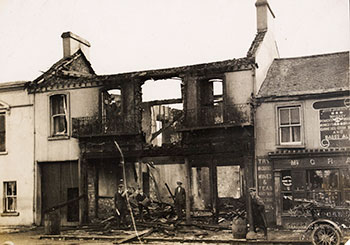100 YEARS AGO: Restoration of Order in Ireland Act
Published in Issue 4 (July/August 2020), Volume 28By Joseph E.A. Connell Jr

Above: Kelly’s shop in Templemore, Co. Tipperary, burnt by British forces in October 1920. Such reprisals weren’t made ‘official’ until January 1921. (NLI)
The violence of the War of Independence was at first deeply unpopular with the broader Irish public, but attitudes changed gradually in the face of the British government’s campaign of widespread brutality, destruction of property, random arrests, reprisals and unprovoked shootings. The small groups of Volunteers on the run were extremely vulnerable. Their success could make or break the activity of the IRA in a particular district—losing them often meant the end of operations. The local populations provided more than just moral support; in many cases they provided logistics, intelligence, and men and women for local actions.
In response to the growing violence, the British government introduced the Restoration of Order in Ireland Act. This act, passed on 9 August 1920, allowed for the non-judicial internment and court martial of civilians and led to the arrest of a large number of IRA officers. The British parliament felt that it had to address the collapse of British civil administration in Ireland. Previous defence of the realm acts were deemed to be ineffective in view of the increased and more widespread violence. The Restoration Act’s aim was to increase convictions of Volunteers while averting the need to declare martial law. Following a guillotine motion, royal assent was received on 13 August 1920.
The bill provided for the replacement of trial by jury with military courts martial in those areas where IRA activity was prevalent and a further extension of the jurisdiction of courts martial to include capital offences. In addition, military courts of enquiry were to be substituted for coroners’ inquests. This was because inquests conducted by local authorities were increasingly finding British soldiers liable in killings of Irish people.
Initially the number of convictions steadily increased to 50–60 per week, leading to increased internments but also to a large number of IRA men on the run. These men could no longer continue in their day jobs while carrying on their guerrilla activities part-time, requiring the IRA to implement a change in approach. The Volunteers were organised into small flying columns or active service units, more suited to ambushes of patrols and convoys than attacks on individuals and barracks as before. The flying columns were mobile units of from ten to 100 men who could strike in devastating ambushes and then melt into a hinterland that they knew far better than the British soldiers who were deployed to fight them.
By October 1920 the ‘King’s writ’ no longer ran in many parts of Dublin or the countryside. All British forces were now being concentrated in the towns, or at least in very strong barracks, obviously with a view to shortening the front. The IRA forces opposing them were becoming stronger and highly organised, albeit with little overall coordination from Dublin. On 10 December 1920 martial law was proclaimed in counties Cork, Kerry, Limerick and Tipperary. In January 1921 martial law was extended to Clare and Waterford.
The level of public support for the IRA, however, continued to rise, although the IRA had shot 182 policemen and 50 soldiers by the end of 1920. The British government had initially asserted that it was dealing with civil disorder rather than war, but by this stage it realised otherwise. The struggle was embittered by successive acts of violence and terror, and by the reprisals and counter-reprisals that followed.
By 1 January 1921 the British government had embarked on a policy of ‘official reprisals’ for IRA activity. Frank Gallagher, writing under the pseudonym David Hogan in The four glorious years, presented a vivid description of the raids and reprisals. And so rebellion continued in Ireland, not with a great take-over of Dublin or with pitched battles but with brutal city and country ambushes designed to demoralise representatives of the British government and the British people themselves.
By the end of spring 1921 the IRA, though a formidable opponent, had not been able to dislodge the British forces, and it became clear that it could not defeat those forces in the field.
Joseph E.A. Connell Jr is the author of The shadow war: Michael Collins and the politics of violence (Eastwood Books).
















